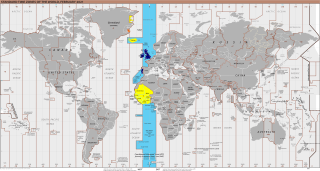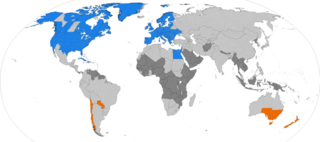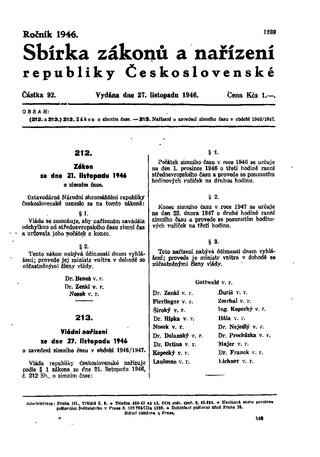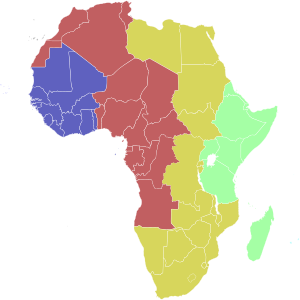
A time zone is an area which observes a uniform standard time for legal, commercial and social purposes. Time zones tend to follow the boundaries between countries and their subdivisions instead of strictly following longitude, because it is convenient for areas in frequent communication to keep the same time.

Western European Summer Time is a summer daylight saving time scheme, 1 hour ahead of Greenwich Mean Time and Coordinated Universal Time. It is used in:

Central European Time (CET) is a standard time of Central, and parts of Western Europe, which is one hour ahead of Coordinated Universal Time (UTC). The time offset from UTC can be written as UTC+01:00. It is used in most parts of Europe and in a few North African countries. CET is also known as Middle European Time and by colloquial names such as Amsterdam Time, Berlin Time, Brussels Time, Budapest Time, Madrid Time, Paris Time, Rome Time, Prague time, Warsaw Time or Romance Standard Time (RST).

Western European Time is a time zone covering parts of western Europe and consists of countries using UTC±00:00. It is one of the three standard time zones in the European Union along with Central European Time and Eastern European Time.

Summer time in Europe is the variation of standard clock time that is applied in most European countries in the period between spring and autumn, during which clocks are advanced by one hour from the time observed in the rest of the year, with a view to making the most efficient use of seasonal daylight. It corresponds to the notion and practice of daylight saving time (DST) to be found in some other parts of the world.

Eastern European Time (EET) is one of the names of UTC+02:00 time zone, 2 hours ahead of Coordinated Universal Time. The zone uses daylight saving time, so that it uses UTC+03:00 during the summer.

Central European Summer Time, sometimes referred to as Central European Daylight Time (CEDT), is the standard clock time observed during the period of summer daylight-saving in those European countries which observe Central European Time during the other part of the year. It corresponds to UTC+02:00, which makes it the same as Eastern European Time, Central Africa Time, South African Standard Time, Egypt Standard Time and Kaliningrad Time in Russia.

Moscow Time is the time zone for the city of Moscow, Russia, and most of western Russia, including Saint Petersburg. It is the second-westernmost of the eleven time zones of Russia. It has been set to UTC+03:00 without DST since 26 October 2014; before that date it had been set to UTC+04:00 year-round on 27 March 2011.

UTC−01:00 is an identifier for a time offset from UTC of −01:00.

UTC+01:00 is an identifier for a time offset from UTC of +01:00. In ISO 8601, the associated time would be written as 2019-02-07T23:28:34+01:00. This time is used in:

UTC+00:00 is an identifier for a time offset from UTC of +00:00. This time zone is the basis of Coordinated Universal Time (UTC) and all other time zones are based on it. In ISO 8601, an example of the associated time would be written as 2069-01-01T12:12:34+00:00. It is also known by the following geographical or historical names:

Central Africa Time or CAT, is a time zone used in central and southern Africa. Central Africa Time is two hours ahead of Coordinated Universal Time (UTC+02:00), which is the same as the adjacent South Africa Standard Time, Egypt Standard Time, Eastern European Time, Kaliningrad Time and Central European Summer Time.

East Africa Time, or EAT, is a time zone used in eastern Africa. The time zone is three hours ahead of UTC (UTC+03:00), which is the same as Moscow Time, Arabia Standard Time, Further-eastern European Time and Eastern European Summer Time.

Europe spans seven primary time zones, excluding summer time offsets. Most European countries use summer time and harmonise their summer time adjustments; see Summer time in Europe for details.

African countries, apart from Egypt, do not use daylight saving time (DST) although some did in the past. Only the territories of the Canary Islands, Ceuta and Melilla (Spain) and Madeira (Portugal) implement DST from the last Sunday in March to the last Sunday in October. Although these regions politically belong to Europe, they are geographically part of Africa. They have DST schedules according to European Union rules.

Daylight saving time (DST), also known as summer time, is the practice of advancing clocks during part of the year, typically by one hour around spring and summer, so that daylight ends at a later time of the day. As of 2024, DST is observed in most of Europe, most of North America and parts of Africa and Asia around the Northern Hemisphere summer, and in parts of South America and Oceania around the Southern Hemisphere summer. It was also formerly observed in other areas.

Winter time is the practice of shifting the clock behind the standard time during winter months, usually −1 hour. It is a form of daylight saving time in which standard time is in effect during summer months, rather than the usual case where standard time is in effect during winter months. However, while summer time is widely applied, use of winter time has been and is very rare.

Namibia since September 2017 is in the Central Africa Time zone at UTC+02:00, congruous with South African Standard Time.
Africa, the world's second-largest and second-most populous continent, spans across six different time zone offsets from Coordinated Universal Time (UTC): UTC−01:00 to UTC+04:00. As Africa straddles the equator and tropics, there is little change in daylight hours throughout the year and as such daylight saving time is currently observed in only one country, Morocco, however it was also previously observed in several other countries.
Time in Benin is given by a single time zone, officially denoted as West Africa Time. Benin adopted WAT on 1 January 1912 as French Dahomey, and has never observed daylight saving time.

 Algeria (as Central European Time)
Algeria (as Central European Time) Angola
Angola  Benin
Benin  Cameroon
Cameroon  Central African Republic
Central African Republic  Chad
Chad  Democratic Republic of the Congo (western provinces)
Democratic Republic of the Congo (western provinces) Equatorial Guinea
Equatorial Guinea  Gabon
Gabon  Morocco (as Central European Time)
Morocco (as Central European Time) Niger
Niger  Nigeria
Nigeria  Republic of the Congo
Republic of the Congo  Tunisia (as Central European Time)
Tunisia (as Central European Time) Western Sahara
Western Sahara 








